Earth Day: Food for thoughts
Globally, it is estimated that we have already clear-cut an area the size of South America to allow farming and even more land to raise livestock. For this 2022 Earth Day, our scientists Katia Nicolet and Beatrice Cordiano show the challenges of feeding our growing population, whereas agriculture already accounts for 35% of CO2 emissions worldwide.
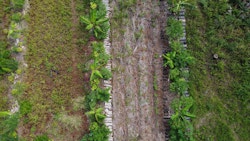
Agroforestry Isle of Pins
8 billion humans to feed
Holding global warming to 1.5°C is still possible, yet according to the latest IPCC report we only have three years left to reach the peak of mankind's emissions and avoid exceeding the crucial limit. Now more than ever, we need to act boldly, broadly and rapidly to cut greenhouse gas emissions.
Since 1970, every 22nd April World Earth Day is celebrated all across the world by more than 193 countries. Back then, the world’s population totalled 3.7 billion people. Today, as we internationally mark the 52nd Earth Day, we are more than twice as many on the planet and we will likely be 2 billion more by mid-century.
There’s no doubt that feeding 8 billion mouths and doing it sustainably, preserving the environment, is a huge responsibility and a colossal task, which becomes even harder under the pressing climate urgency.

Friday for future
Meeting the growing need for food
When it comes to mitigating the effects of climate change and curbing emissions, we tend to focus on energy solutions such as enhancing energy efficiency, transitioning to renewable sources, deploying a low-carbon mobility and we forget a major share of the emissions: agriculture and, to a wider extent, food.
Historically, we have chopped down forests to make space for food production and cattle. Globally, it is estimated that we have already clear-cut an area the size of South America to allow farming and even more land to raise livestock. This has caused the loss of thousands of species and of entire ecosystems, it has also released incredible amounts of greenhouse gases.
According to the Food and Agriculture Organization (FAO), agricultural expansion drives almost 90% of global deforestation, but we can no longer afford to boost food production at the expenses of forests and grasslands.
Agriculture has already made giant leaps towards environmental sustainability. Over the last 60 years, world population more than doubled and global food production more than tripled, while land use increased by roughly 15% and the use of pesticides on farmland has fallen by 95% thanks to improvements in chemistry.
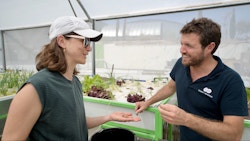
Green in the city
Praiseworthy, yet not enough. As of today, agriculture is responsible of 70% of the world's freshwater consumption and with yearly CO2-equivalent emissions in the range of 16 and 17 billion tonnes - as reported by a recent study - it accounts for 35% of global greenhouse gases emissions: more than all our cars, trains, ships and planes combined. Moreover, we produce enough food to feed the whole planet 1.5 times, still around one tenth of us are undernourished.
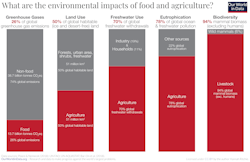
What are the environmental impacts of food and agriculture?
Agriculture is essential to our survival, but is a major emitter contributing to global warming and is itself a victim of climate change: warmer temperatures, changes in precipitation patterns, more frequent and intense weather events have direct and indirect effect on this sector and might disrupt food productivity, availability and quality. Therefore, agriculture must be part of the solution.
The agricultural foodprint
Food is not only a basic human need. People love food, it is representative of our cultures. But do we have any idea of what its environmental footprint is?
It takes energy, water and land to grow everything we eat and GHG emissions are produced during production, packaging, transport and even waste.
Let’s take 1 kg of apples, 0.6 m2 of land are required to produce it. 2.8 are needed to harvest 1 kg of rice and 21.6 for coffee. Beef takes 326.2 m2. It is estimated that 4 675 million hectares globally today is agricultural land, which is about 30% of the total land area on our planet, excluding areas covered by snow and ice. Of this, 30% is cropland and 70% is grazing land for livestock, but if the surface area to grow crops for animal feed is considered, land use for meat production is five time that of the land used to produce plant-based food.
Now let’s use the same examples and look at how much water is needed. 833 litres for apples, 1 670 for rice, 1 040 for coffee and 15 400 for beef!
If we look instead at the total GHG emissions per kilogram of food: producing apples will generate 0.4 kg of CO2-equivalents, rice 4, coffee 17 and beef 60. According to EDGAR-FOOD, taking into account all these factors, an average person produces 2 tons of CO2-equivalent emissions per year only for food, namely 5 economy flights from Amsterdam to Rome.
When it comes to emissions, there are many factors at stake: energy use on the farm, emissions from crop production, fertilizers and manure, methane from cattle, land use and deforestation, supply chain etc. It is not just carbon dioxide either: large quantities of GHGs are released as methane (CH4) and nitrous oxide (N2O).
Of all these GHG, one third comes from “land use change”, caused mainly by deforestation and drainage and burning of organic soils to expand farms. A recent study has estimated CO2-equivalent emissions of land use change to be about 5 billion tonnes a year (5 000 Tg CO2eq/yr).
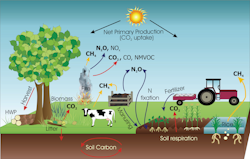
Farming emissions sources
A meaty challenge
You will have understood by now, food production is responsible for a large share of our GHG emissions every year. Globally, we estimate about 17.3 billion tonnes of CO2 equivalent are released in the atmosphere every year to produce the food we eat. But not all foods are equal when it comes to their foodprint: 57% of all GHG emissions are for the production of meat (including animal feed), 29% for the production of plant-based foods and 14% for other utilization like the production of rubber, fibre or cotton. Meat production, as we have said, demands more land, uses more water and emits more GHG emissions. But why?
This stark difference between plant-based food and animal-based food comes from the “average conversion efficiency” from feed to livestock. A very complicated sentence to say that it is not efficient to feed a cow to produce a kilogram of beef. The efficiency is about 5.2% based on biomass (1kg), 6.2% based on calories (energy you gain from eating said kg) and 8.5% based on protein. So, if you want to produce 1 kg of beef (biomass), you need to feed your cow 20kg of plants! When it comes to food security, these 20kg of plant-based food can feed more people than the one kilo of beef. Also, plants capture some amount of CO2 during their growth, while livestock (especially cattle) releases a lot of CO2 and methane during their live.
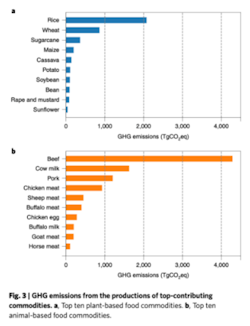
GHG emissions from the productions of top-contributing commodities
A call for change
While switching your lightbulb might not have the biggest impact on our climate’s health, curbing CO2 emissions of one of the most polluting industry on earth just might help – a lot. Remember, 35% of all global anthropogenic emissions are a result of food production, and as we saw, meat is a much larger emitter than plant-based food.
The IPCC report from august 2019 warned that the efforts to reduce emissions will fall significantly short without drastic changes in global land use, agriculture and human diet. If people, especially in rich countries, became vegan, this dietary change could reduce global CO2 emissions by 8 billion tonnes per year (compared to the “business as usual” scenario). Without going that far, adopting a mostly vegetarian diet with an occasional supplement of meat and dairy (once a week) could avoid the emission of about 4 to 5 billion tonnes of CO2 a year, or about 9% of global emissions – that’s not peanuts.
If adopting innovative farming techniques and sustainable practices and capturing and valorising the methane produced from manure are fundamental solutions at an industrial level, reducing your meat and dairy consumption is the single most effective action you can take to reduce your footprint. This will save vast areas of land, millions of litres of fresh water, slow down deforestation and decrease you related GHG emissions significantly. With climate change, farming land will become scarcer, if we want to feed the predicted 10 billion people in 2050, we better make sure fertile land is used to grow food for humans, and not –as it is today- mostly for livestock.